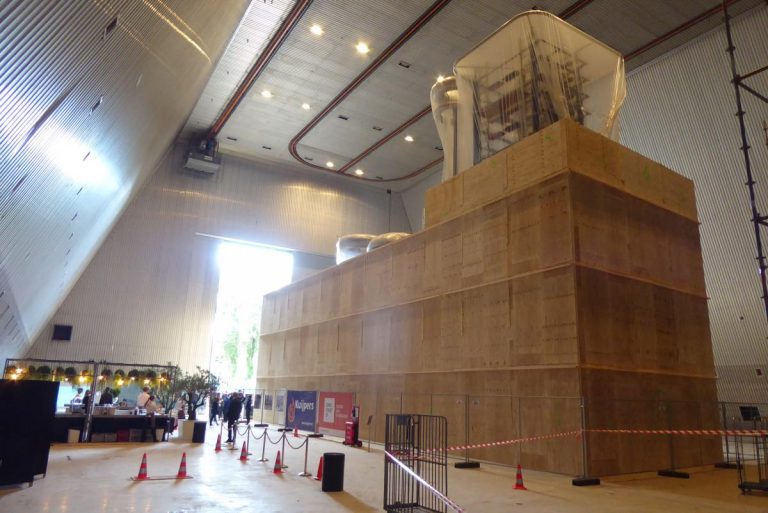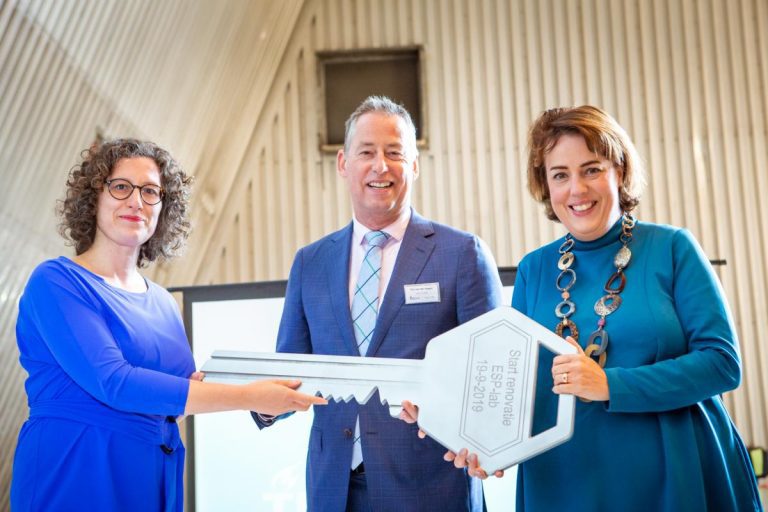In preparation for the energy transition, the EEMCS Faculty is transforming its high voltage lab into the Electrical Sustainable Power (ESP) Lab. Delivery by spring 2021.
Artist's impression of the ESP Lab.
 (Photo: Jos Wassink)
(Photo: Jos Wassink)
The cathedral-like hall is even impressive when half-empty. The immense high-voltage equipment, with its extensive insulators and ring-formed conductors, has been assembled in the middle of the hall. All around it, space has been made for the new challenges in power production and distribution.
There was a last celebration event on Thursday 19 September before the builders take over. The contractor’s CEO Aukje Kuijpers said the building and installation would take 12 months, after which TU staff would have six months to test and tune all the new equipment.
Professor Miro Zeman, head of the Electrical Sustainable Energy (ESE) group at the Faculty of Electrical Engineering, Mathematics and Computer Sciences (EEMCS), explained the challenges for the power sector. The current power grid took 50 years or more to develop. It works almost perfectly, but it has to be transformed to cope with 70% renewable power (sun and wind) by 2030, large-scale distributed generation, and an increase in demand because of the anticipated surge in electric vehicles.
These challenges prompted the ESE staff to put their efforts over at least five years into developing a literally unique lab that would integrate high voltage transport, distribution networks, distributed power generation, and AC and DC microgrids – all interwoven and fully functional in one new Electrical Sustainable Power (ESP) lab. The project cost EUR 20 million.
The ESP lab became feasible through the involvement of TenneT, the Dutch transport grid provider. TenneT’s CEO at the time, Mel Kroon, and EEMCS Dean Professor John Schmitz signed the partnership last year.
TenneT’s new CEO, Manon van Beek, identified the main challenges for the Dutch and German grid (TenneT is big in Germany as well): grid expansion, digitalisation, and the transition from gas to renewables. “The biggest question is how to maintain our current degree of reliability (99.9988%) beyond 2030 if there is no sun or wind available,” she told the audience.
“We will build a twin of the Dutch power grid,” said Professor Peter Palensky (intelligent power grids at EEMCS). The Real Time Digital Simulator (RTDS), which can currently simulate a quarter of the Dutch grid, will be extended to the entire Dutch power grid. That will allow operators to test various issues, for instance, the consequences of new extensions prior to installation, or blackout simulation and how to contain them.
Both Rector Tim van der Hagen and EEMCS Dean John Schmitz underlined the open character of the ESP laboratory, and welcomed interested parties from industry and research institutes to become partners in this future power lab.
More info on the EEMCS website
 Aukje Kuipers receives the key from Tim van der Hagen and Manon van Beek. (Photo: Annelies van ‘t Hul)
Aukje Kuipers receives the key from Tim van der Hagen and Manon van Beek. (Photo: Annelies van ‘t Hul)Do you have a question or comment about this article?
j.w.wassink@tudelft.nl


Comments are closed.